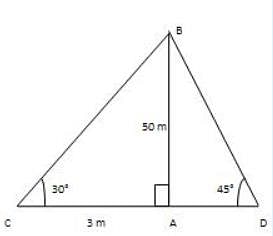RRB Junior Stenographer Mock Test - 7 - RRB NTPC/ASM/CA/TA MCQ
30 Questions MCQ Test RRB Junior Stenographer Mock Test Series 2025 - RRB Junior Stenographer Mock Test - 7
Which one of the following pairs is mismatched
In which year was the National Bank for Agriculture and Rural Development (NABARD) established during Indira Gandhi's tenure?
| 1 Crore+ students have signed up on EduRev. Have you? Download the App |
Lord Dalhousie’s annexations had caused suspicion and uneasiness in the minds of most ruling princes in India. Which one of the following states was not annexed by the British under Dalhousie’s Doctrine of Lapse?
In this questions, a number series is given with one term missing. Choose the correct alternative that will continue the same pattern and fill in the black spaces.
Q. 1, 2, 3, 6, 9, 18, (___), 54
Find the area of a triangle whose base is 4 cm and altitude is 6 cm.
The fertility of soil starts getting badly impacted when pH of soil exceeds:
A box contains 90 blue balls, 110 red balls, 150 black balls and 50 pink balls. 50% of blue balls and 70% of red balls are taken away. What percentage of the initial number of balls are remaining in the box?
Two men are inverse sides of a tower. They gauge the edge of the rise of the highest point of the tower as 30° and 45° respectively. On the off chance that the tallness of the tower is 50 m, discover the separation between the two men. (Take √3=1.732)
The 73rd Constitutional Amendment, passed during Narasimha Rao's tenure, relates to:
Identify the irrational number among these.
Assertion (A): The Government of India Act, 1919, led to significant political changes in India by introducing responsible government at both the central and provincial levels.
Reason (R): The act was designed to fulfill the British government's promise of gradual development towards self-governing institutions in India by implementing a dual government system known as Dyarchy.
How many prime number are there between 0 and 30 :-
The partition of Bengal by Lord Curzon intended to
1. Curb Bengali influence
2. Divide people based on religion
3. Achieve administration convenience
Which of the above statement(s) is/are correct?
Direction: Study the following information carefully and answer the given questions besides.
M, N, O, P, Q, R, S and T are sitting around a circular table and all are facing the centre of the table. M is sitting fourth to the right of N. P is sitting second to the left of N. Q is sitting third to the right of S. T is sitting second to the left of O. S is not sitting beside P. O is not sitting beside M.
Q. Who among the following sits exactly opposite to Q?
Directions: In each of the following questions, a sentence has been given in Active (or Passive) Voice. Out of the four alternatives suggested, select the one that best expresses the same sentence in Passive/ Active Voice.
All the examinees have answered one particular question in the long answer writing section.
Choose the correct option to mark the synonym of the words given in the question.
Frivolity
Since the beginning of history
P: have managed to catch
Q: the Eskimos and Red Indians
R: by a very difficult method
S: a few specimens of this aquatic animal
The Proper sequence should be:
Direction: In the following questions, out of the four alternatives, choose the word opposite in meaning to the given word.
Accord
In the following question, out of the four alternatives, select the alternative which is the best substitute for the phrase.
Q. To stay away from something or some habit.
Directions: In the following question, a sentence is given with a blank to be filled in with an appropriate word. Select the correct alternative out of the four and indicate it as your answer.
Kalidas, _______ wrote some fine dramas, is famous.
Direction: In these Questions, Out of the four alternatives choose the one which can be substituted for the given words/sentence.
One not concerned with right or wrong.
Each species has its special place or habitat. An (31)____ bird watcher can look at (32)____forest, meadow, lake , swamp or field and (33)____ almost exactly what birds he (34)____find there (35)____birds are found all over the world; others (36)____ themselves to certain areas. Still (37)____migrate from one country to another in (38)____in search of warmth and (39)____, and then return in spring,(40)____the season is more favourable.
Q. Find the word most appropriate for Blank No. 32
Direction: In the following question, the sentences have been given in Active/ Passive Voice. From the given alternatives, choose the one that best expresses the given sentence in Passive/ Active Voice.
The doctor advised the patient not to eat rice.






 in the form of a fraction is
in the form of a fraction is 




















